Family : Rafflesiaceae

Text © Prof. Pietro Pavone

English translation by Mario Beltramini
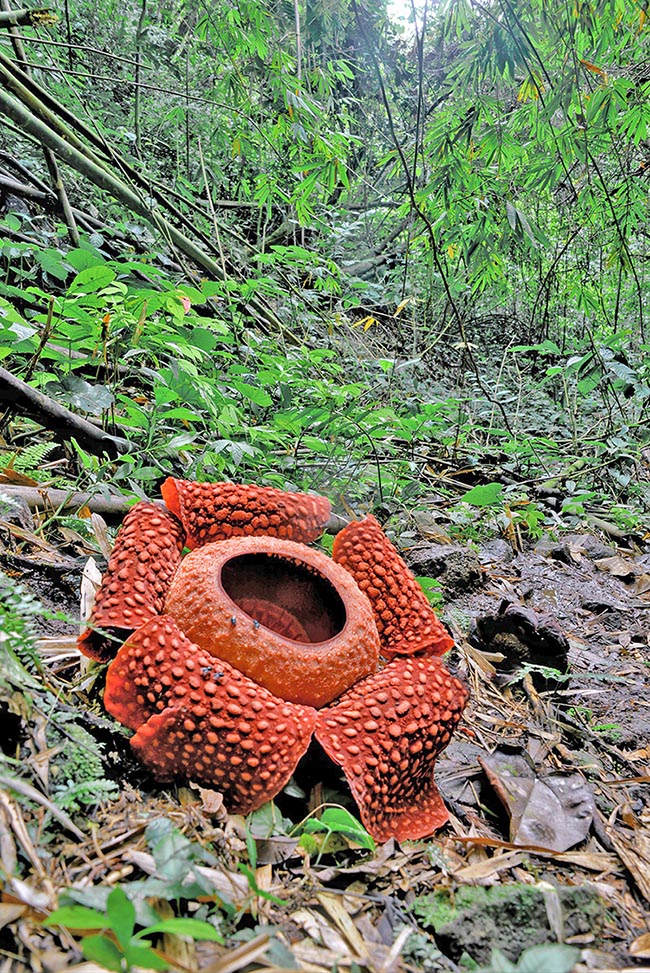
The world largest flower measures up to 107 cm with a weight that may reach 7 kg © narido
Rafflesia arnoldi R. Br. (1821) belongs to the family Rafflesiaceae, known because it includes species strictly parasitic on the roots and the stems of other species of plants.
The family, subdivided in three genera: Rafflesia with 42 species, Rhizanthes with 4 species and Sapria with 4 species too, is diffused in the tropical forests of southern China, Tibet, Myanmar, Thailand, peninsular Malaysia, Borneo, Java, Sumatra and Philippines.
Rafflesia arnoldi has been discovered in 1818 in the rainforest of today’s Indonesian island of Sumatra by the British officer Thomas Stamford Raffles (1781-1826), British colonial officer, and by Joseph Arnold (1782-1818), surgeon and naturalist.
To tell the truth, it was Arnold who discovered it first because, during his voyage towards south Sumatra, had separated from the group led by Raffles, as he wanted, together with a few Malay porters, to explore the forest independently.
Thanks to the report of one of his companions, Arnold soon found himself faced to a huge flower, never seen before, with a corolla larger than one metre having fleshy red petals, speckled with white.
The surprise was enormous.
Shortly after, the other members of the expedition did arrive and they too were astonished at the discovery.
Arnold drew and collected the specimen that weighed almost seven kilos, however, due to the fever he had contracted during his excursions he died little after and he could not finish the drawing and the description of this interesting plant.
Arnold’s notes, the drawing, the buds and part of the flower were sent to London to theIn attention of Sir Joseph Banks (1743-1820) who entrusted them for the recognition and description to Robert Brown (1773-1858). In fact, it was he who described this species on Account Rafflesia: 7, tt. XV- XXII (1821) based on what had been received.
In some scientific texts, after a wrong application of the Art. 60 of the International Code of Nomenclature (2018), is reported the binomen Rafflesia arnoldii R.Br., but the specific epithet given by Brown is “arnoldi” because the genitive of the Latinized form well established of Arnoldus, not correctable in“arnoldii”.
Rafflesia arnoldi is native to Borneo and Sumatra and can be found in the secondary rainforests as well as in the primary ones usually close to the water and between 490 and 1.024 m of altitude.
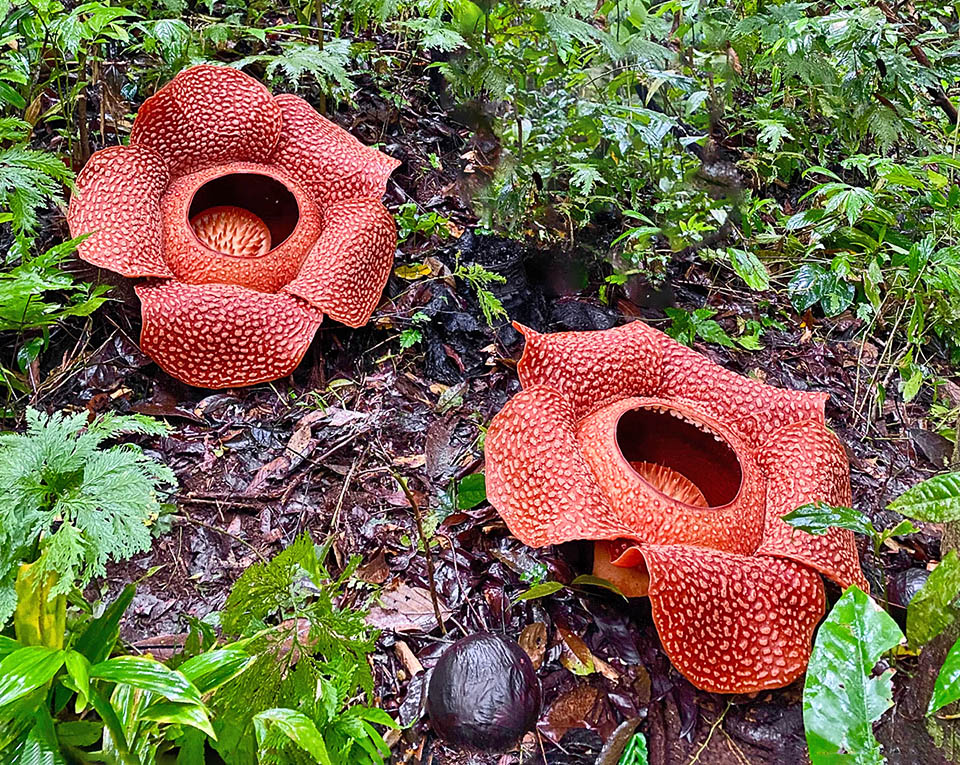
It’s Rafflesi arnoldi, native to Borneo and Sumatra forests, usually growing near the water, between 490 and 1024 m of altitude © ziagz
The name of the genus Rafflesia comes from Thomas Stamford Raffles and the specific epithet arnoldi from Joseph Arnold.
The common names in English are: Corpse flower, Giant padma.
The name “corpse flower” has been given because while flowering the flower emits a smell of rotting carcass that serves for attracting the pollinators. In Sumatra Island there is another species, phylogenetically distant, also called “corpse flower”.
It is the Amorphophallus titanum whose enormous inflorescence, formed by several flowers, also emits a putrid odour for attracting the pollinators.
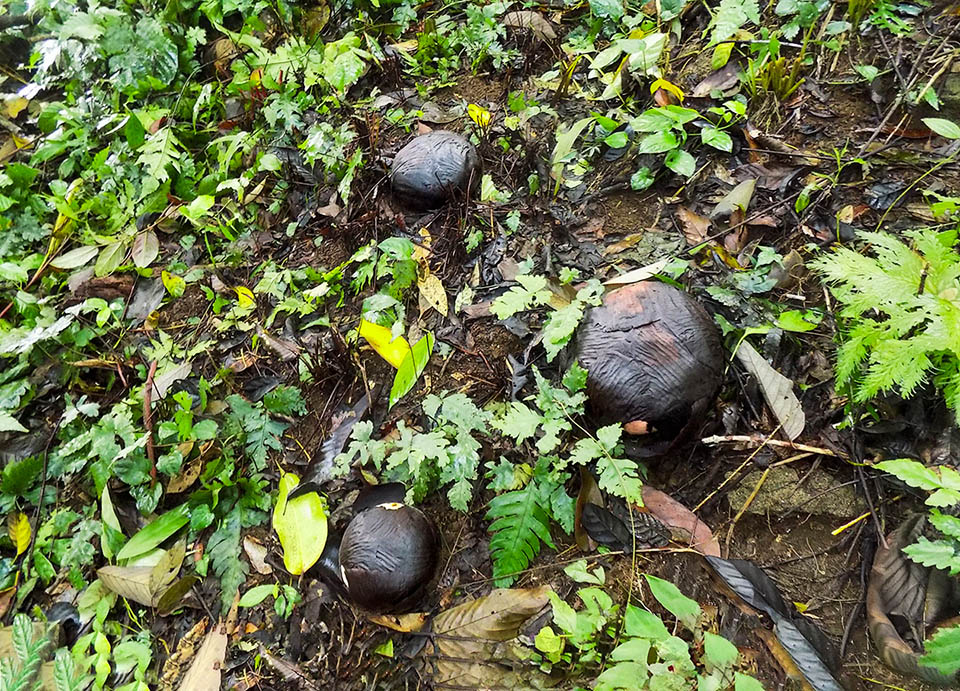
It’s a parasite. The flower begins with a brown bud connected to the root of the host plant and then the blossom covers of black bracts © Irfan Nurarifin
Rafflesia arnoldi is a holoparasite plant, that is, an obligate parasite that cannot live without the host.
As a matter of fact, its vital cycle depends totally from another vegetal species (host) that is the tropical vine Tetrastigma leucostaphylum (Dennst.) Alston.
This is a woody shrub that climbs other trees with warty stems and with rather short and forked tendrils for gripping that harden with age.
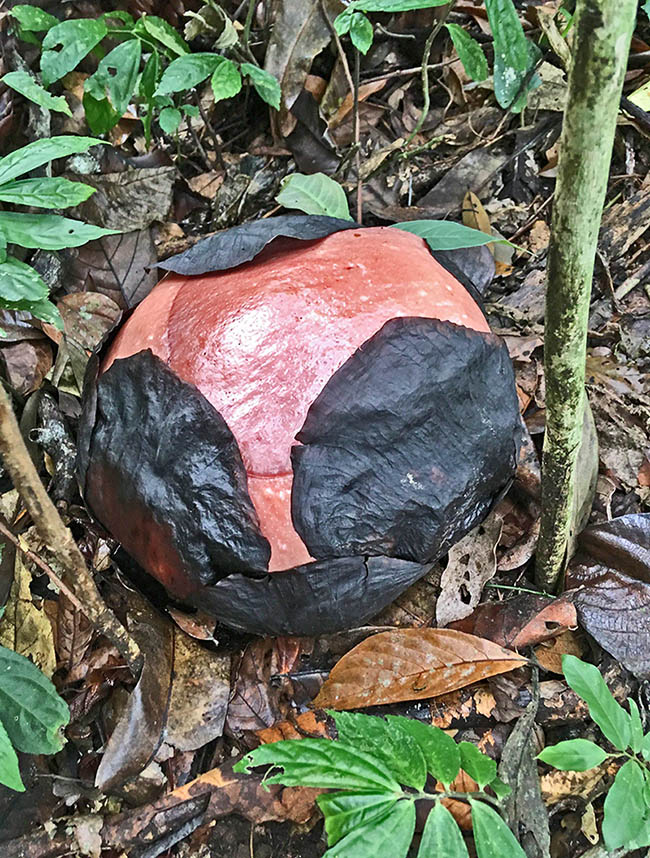
When opening they show the protected inner corolla with functions similar to sepals of traditional flowers © Max Allen
Rafflesia arnoldi, unable to perform photosynthesis, for feeding it attaches to the roots of the host plant by means of a haustorium, an organ that penetrates the vascular system of the host plant to extract water and nutrients.
During this intimate connection the Rafflesia in addition to taking nutrients, steals mitochondrial genes, up to the 40%, integrating them into their own genome, in order to suppress the host’s defenses and consequently to facilitate its own growth.
After several months the flower forms on the outside with its particular morphology and measures up to 107 cm with a diameter and a weight of 7(11) kg.
Due to these dimensions the flower of Rafflesia arnoldi is the largest in the world.
The formation of the flower begins with a brown gemma, visible from the outside, connected to the root of the host plant that grows through different stages.
The initial stage is called copular and takes 6 to 9 months, then forms the bracteal stage as the bud covers of bracts, with function similar to that of the sepals in the traditional flowers, and lasts 3-5 months and finally we have the final stage of anthesis with structures similar to the petals that may persist for a few days or, at most, 1-2 weeks, before starting the decomposition.
In this stage the flowers have five lobes, are brown-reddish with white dots and measure about one metre of diameter emitting a smell of rotting meat.
The flowers are dioecious, that is male and female flowers therefore for the reproduction the pollen must be transferred from the male flowers to the female ones.
The stigmas in the female flowers as well as the stamens in the male ones are attached to a disc having spiny outgrowths located inside the flowers.
The environmental conditions at the time of flowering include temperatures included between 24-25 °C and humidity around 80-85%.
To favour pollination, the flowers of Rafflesia arnoldi also produce heat, which helps in spreading the unpleasant smell.
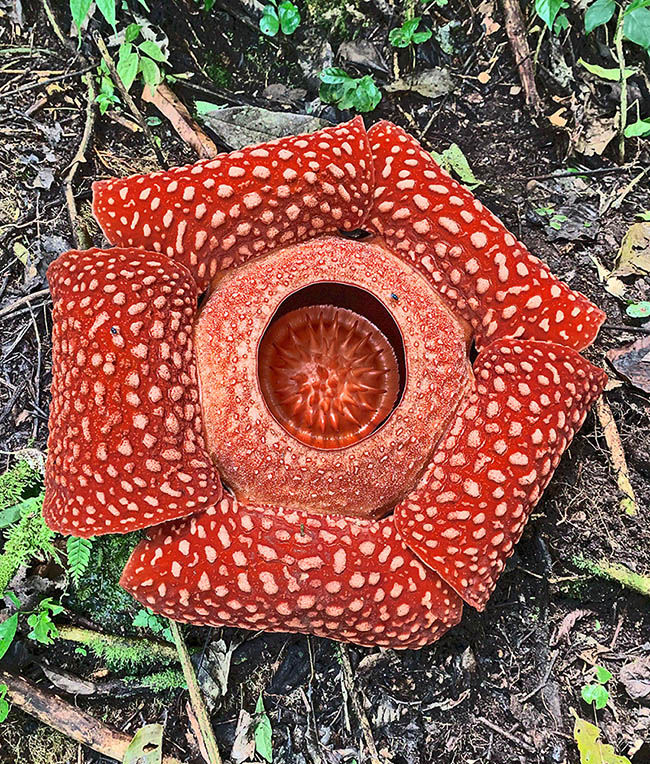
Anthesis stage. Are visible 5 petals and the inner disc remaining wholly open a few days for the pollination © anneliseruys
The pollinators found are several, among the Dipterans we mention a type of aphid (Lucilia sp.), the Grey fly (Sarcophaga sp.), the Fruit fly (Drosophila colorata) and the Blue bottle fly (Calliphora vomitoria); among the Hymenopterans the Jet black ants (Lasius fuliginosus) and among the Coleoptera some staphylinids.
The pollen of Rafflesia arnoldi, unlike many other pollens, is immersed in a thick and sticky liquid that dries up on the back of the pollinators and can be carried for various kilometres before pollinating another flower.
If pollination is successful, a spherical berry gets form containing numerous tiny seeds that can germinate only if in touch with the tissues of the host plant (Tetrastigma) and so begin a new vital cycle.
The seeds are dispersed by animals like wild pigs, ground squirrels, ants, termites, etc.
It is likely that the small appendix rich in fats (elaiosomes) present in the seeds may be appreciated by the ants that, after having consumed them, abandon the seeds in the anthill facilitating in such a way their dissemination.
Here the seeds germinate and if there are present roots of the host plants they do infect it.
The vital cycle (from seed to seed) of different species of Rafflesia is about 4 years.
Rafflesia arnoldi has two varieties: Rafflesia arnoldi var. arnoldi and Rafflesia arnoldi var. atjehensis (Koord.) Meijer.
Phylogenetic studies have highlighted that the big size of the flower of the genus Rafflesia has been relatively recent and rapid, with an average increase of the diameter of the flower of about 20 cm per one million years.
Moreover it has been discovered that the genes present in Rafflesia, with the loss of the genome of the chloroplasts could have been taken to the host Tetrastigma (horizontal gene transfer).
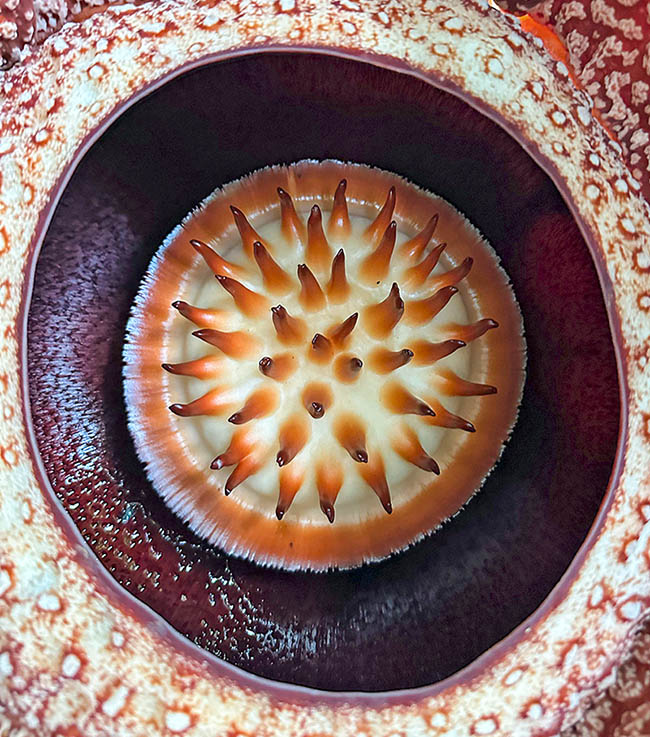
Inner disc with outgrowths where are stuck the stigmas in the female flowers or the stamens in the male © ccgfh
As the Indonesian species are monophyletic, the increase of the diversification can be explained with the climate changes happened from the Middle Miocene (about 15 million years ago) to the Pliocene (about 5-2,6 million years ago) that have favoured, by natural selection, the shift of characters towards the size of the flowers.
From the study of about 11.500 bases of the genome of Rafflesia it seems that this genus should descend from a group related to today’s family Euphorbiaceae that includes plants characterized by small flowers merged in a particular inflorescence, called cyathium, that looks like one single flower.
After this study, the flower of the genus Rafflesia has first undergone a rapid growth in size, increasing up to 73 times its ancestral diameter (in about 46 million years), to then return to a more contained evolutionary growth.
This is one of the most amazing examples of development in the plant world.
Due to its very limited distribution Rafflesia arnoldi is particularly vulnerable to the destruction of its habitat.
At times its populations contain only a few individuals in areas not protected and at critical risk of passage to agriculture.
Moreover, the plant, due to the big size of the flower, has been collected for decades to the point that it has become very rare and at risk of extinction.
Presently its protection “in situ” is entrusted to the Kerinci Seblat National Park that extends for 13.791 square kilometres including four provinces: Bengkulu, Jambi, West Sumatra and South Sumatra.
In this Park there are more than 40000 vegetal species.
Recently, to the conservation “in situ”, is being added the conservation “ex situ” of Rafflesia arnoldi even if it is challenging seeing that this endemic species is highly dependent on its host.
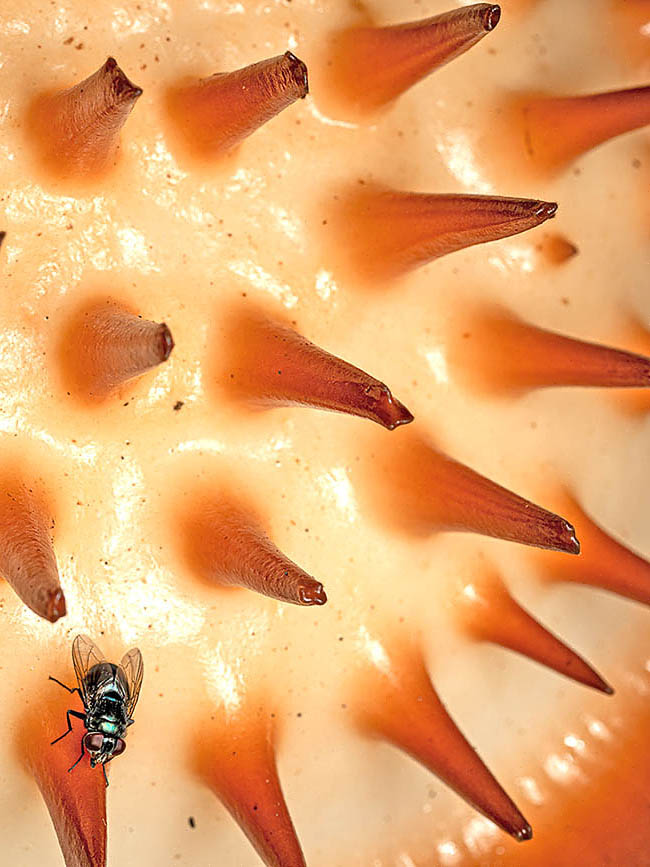
For reproduction the pollen is immersed in a thick and sticky liquid that dries up on the back of the pollinators like this fly attracted by smell and can be carried even for several kilometres before pollinating another flower © Eidiu
In the Bogor Botanical Gardens, in the outskirts of Jakarta, Indonesia, they have obtained the formation of a flower of 60 cm in diameter.
For facing these threats, the scholars recommend that all Rafflesia species are to be immediately added to the IUCN Red List of the endangered species.
At the moment only Rafflesia magnifica Madulid, Tandang & Agoo, synonym of Rafflesia mira Fernando & Ong., is included in the category Critically Endangered (CR).
Another conservation strategy is that based on ecotourism.
Shape, size and colour of the flower of Rafflesia arnoldi may be utilized for attracting the tourists.
This is a strategy, source of structures and infrastructure, in support of conservation of this particular endemic plant.
Even though ecotourism might represent one of the main threats for the species due to the stamping and to the possible thefts.
Not by chance the tropical rainforest of Sumatra in 2004 has joined UNESCO (United Nations Educational, Scientific and Cultural Organization).
The site “Sumatran Tropical Rainforest Heritage” extends over 2,5 millions of hectares and includes three national parks: the Gunung Leuser National Park, the Kerinci Seblat National Park and the Bukit Barisan Selatan National Park.
It hosts numerous species at risk of extinction and overall hosts about 10.000 vegetal species, more than 200 species of mammals and about 580 species of birds.
They are also looking to involve the local communities in the conservation with a preliminary approach to the education and the socialization that aim to make people understand the importance of the maintenance of the local biodiversity.
The flower Rafflesia arnoldi, an iconic symbol of the South-East Asian rainforest, has been represented on several Indonesian stamps. Moreover, with the 1993 No. 4 Presidential Decree the plant has been officially recognized as a national “rare flower” (sang puspa langka).
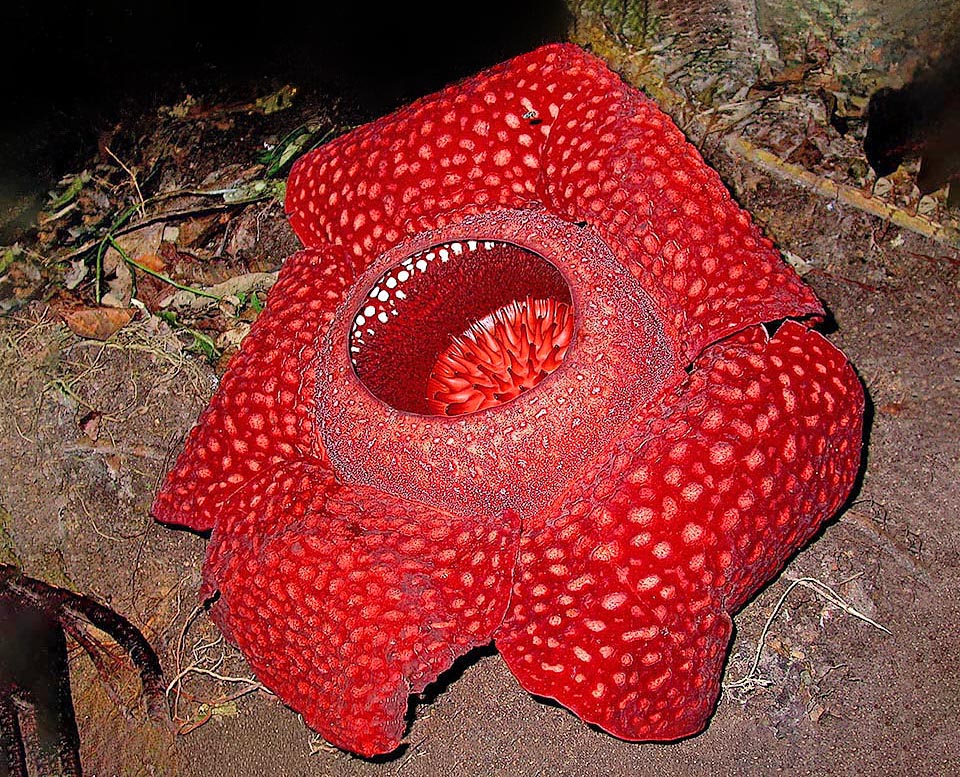
In Indonesian traditional medicine the plant was used to favour the postpartum recovery, sure it helped to expel the placenta, to stop haemorrhages and even as aphrodisiac. Recent studies suggest that Rafflesia arnoldi could have anti-cholesterol, respiratory antiviral, healing and antifungal properties © zanskar zanskar
In the traditional Indonesian medicine the buds of the flowers were used to favour the postpartum recovery, to stop the hemorrhages and as aphrodisiac. The North Borneo indigenous populations believe that drinking an infusion of the plant after the delivery helps in expelling the placenta. The effectiveness and the chemical basis of these uses are not clear and the applications are probably linked more to the cultural symbolism and the look of the flower than to proven chemical properties. However, recents research concerning the metabolites present in the flowers of Rafflesia, suggest that the plant might have anti-cholesterol, respiratory antiviral, healing and antifungal properties.
Synonyms
Rafflesia titan Jack in App. Descr. Malayan Pl.: 1 (1821).
